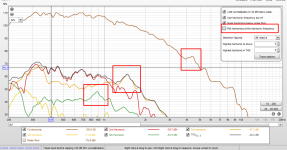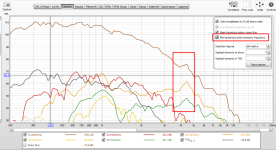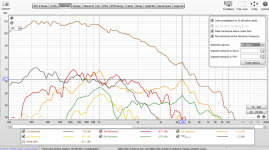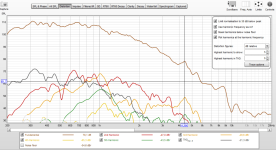I should have taken my double espresso first , you are correct the peaks appear on the same frequencies.
In case my posts are hard to read 😀 here is demonstration, in REW one can plot the distortion on the root frequency or at the actual frequency it is measured:


Btw. the photos are of a midrange with DSP only, these I've posted on this thread earlier already. The main output at cone resonance about 4.5kHz is dealt with DSP, but the distortion shows peaks on it as expected. If parallel notch in series with the driver was used instead, also the distortion peaks would have dropped.
And look, the third harmonic of ~1.5kHz is only about 14-15db shy of the main signal acoustic output at 4.5kHz, thats about 20% distortion!

I didn't have suitable parts for the notch, but using just a series coil in combination with DSP low passes some of the distortion as well, as it should. About 3% distortion in this case. The distortion would be even lower, if there was also a notch filter.

This is one example why make a hybrid crossover. Basically, DSP low passes the main signal, while it doesn't low pass distortion generated passband within the driver itself. This makes the relative distortion huge, and perhaps audible. Series impedance low passes also (some of) the distortion, maintaining the ratio. I should have demonstrated steeper acoustic filter here, it is possible that main signal is low passed hard in DSP so that distortion could be over 100%!
ps. If someone hears difference between active and passive speakers given that they had matched acoustic response and DSP is of fine quality, it's very likely stuff like this is what makes the difference. While both passive and active can be used to make pretty much same acoustic frequency response, impedance in series with driver would be the only difference between the two. This would affect distortion, and could affect other things like electrical damping at drivers resonance for example. And point is, there is no need to debate which one is better or not, just make best you can do with what you have.


Btw. the photos are of a midrange with DSP only, these I've posted on this thread earlier already. The main output at cone resonance about 4.5kHz is dealt with DSP, but the distortion shows peaks on it as expected. If parallel notch in series with the driver was used instead, also the distortion peaks would have dropped.
And look, the third harmonic of ~1.5kHz is only about 14-15db shy of the main signal acoustic output at 4.5kHz, thats about 20% distortion!

I didn't have suitable parts for the notch, but using just a series coil in combination with DSP low passes some of the distortion as well, as it should. About 3% distortion in this case. The distortion would be even lower, if there was also a notch filter.

This is one example why make a hybrid crossover. Basically, DSP low passes the main signal, while it doesn't low pass distortion generated passband within the driver itself. This makes the relative distortion huge, and perhaps audible. Series impedance low passes also (some of) the distortion, maintaining the ratio. I should have demonstrated steeper acoustic filter here, it is possible that main signal is low passed hard in DSP so that distortion could be over 100%!
ps. If someone hears difference between active and passive speakers given that they had matched acoustic response and DSP is of fine quality, it's very likely stuff like this is what makes the difference. While both passive and active can be used to make pretty much same acoustic frequency response, impedance in series with driver would be the only difference between the two. This would affect distortion, and could affect other things like electrical damping at drivers resonance for example. And point is, there is no need to debate which one is better or not, just make best you can do with what you have.
Last edited:
Question: these measurements are made with REW, would Arta STEPS give a similar result?
Reason: i find Rew very difficult to use, i prefer Arta.
My use case: i am working on "purifiing" my GAYA2 speakers. And can do this type of test on the 8" and 4" drivers.
Reason: i find Rew very difficult to use, i prefer Arta.
My use case: i am working on "purifiing" my GAYA2 speakers. And can do this type of test on the 8" and 4" drivers.
Hi, for sure, distortion is distortion 🙂 except, I cannot find setting in ARTA or in STEPS to change whether distortion is plotted at root frequency or at the harmonic frequency. Still, you'll see difference if you measure with/without passive parts and compare the two.
Calibration isn't needed for those kind of distortion measurements.
Calibration is only needed for frequency response accuracy.
Not for looking at relative differences.
I use the regular ARTA, center impuls response and hit f12 to get the distortion.
In this case it has to be at least 96kHz sampling rate.
The previous results could have changed every so slightly because the 2nd time I think he measured the other tweeter.
It's not relevant for the results.
Calibration is only needed for frequency response accuracy.
Not for looking at relative differences.
I use the regular ARTA, center impuls response and hit f12 to get the distortion.
In this case it has to be at least 96kHz sampling rate.
The previous results could have changed every so slightly because the 2nd time I think he measured the other tweeter.
It's not relevant for the results.
I've got beyer mic as well, I think its the mm1. I've got calibration file for it, but haven't bothered with it yet 😀 the error is not too big, and I'll adjust top and bottom to taste anyway, perhaps it would be closer with calibration. Point is, haven't stressed about it too much.@tmuikku , what mic did you use with Rew? My problem with rew is to calibrate it with mics like beyerdynamic mm01 (so no umik mic).
But i want to contribute to this theme.
I have calib file, but it is the level calibration i cannot get right.
bit offtopic,and I'll adjust top and bottom to taste anyway
Nothing wrong with this, but what I noticed over the years is that after a while you loose a bit of control and repeatability of measurements.
Which is fine if you make just a few speakers.
But it becomes quite annoying when you do quite a bit over those years and want to compare to others.
That being said, at home I also use a beyer mic and they seem to be pretty flat.
Within in Europe it's not expensive to get them calibrated.
https://shop.hifi-selbstbau.de/produkt/mikrofonkalibrierung/
for example.
25 euro for 0 degrees, 40 euro for 0 + 90 degrees.
exl shipping obviously.
Again, not needed for these tests.
I think this one was done with a simple Dayton mic (I will ask him).
Beyerdynamic mm1 , and they provide a calib file upon request, but has no data below 50 Hz. Their argument: you do not hear below 50 Hz.
Hifi selbstbau did a good job with my samson mic, will send my mm1 to get it properly calibrated.
I too prefer repeatability in measurements.
Hifi selbstbau did a good job with my samson mic, will send my mm1 to get it properly calibrated.
I too prefer repeatability in measurements.
- Home
- Loudspeakers
- Multi-Way
- Passive crossover parts in active speaker system? Possibilities of hybrid crossover